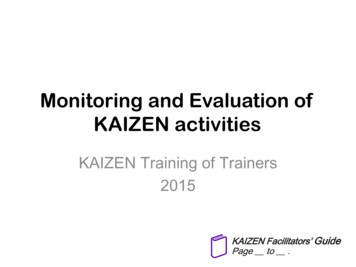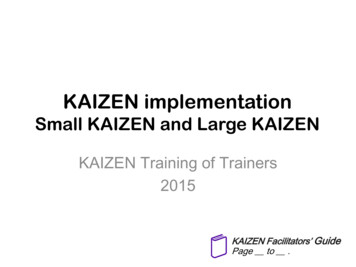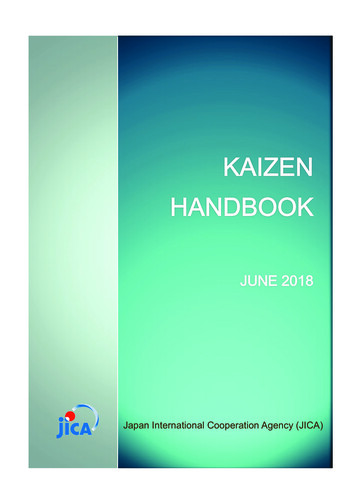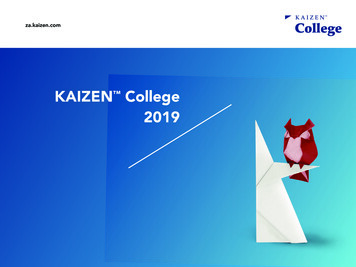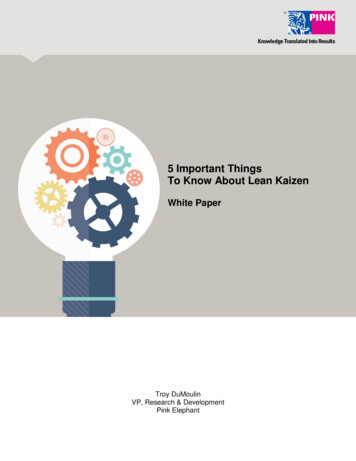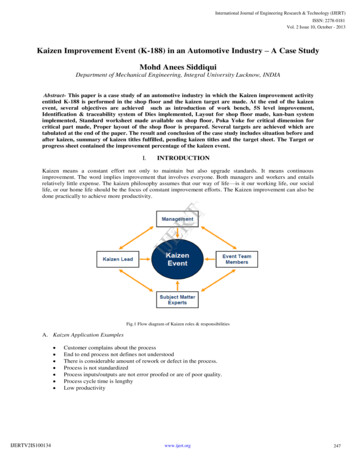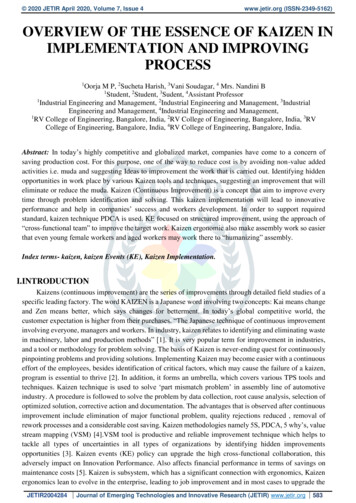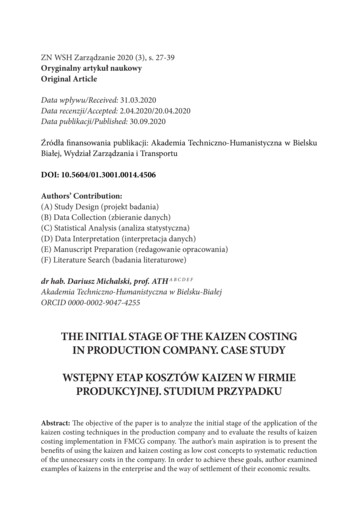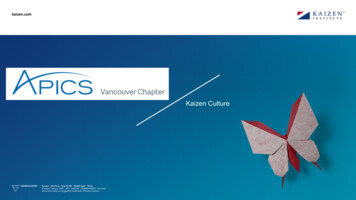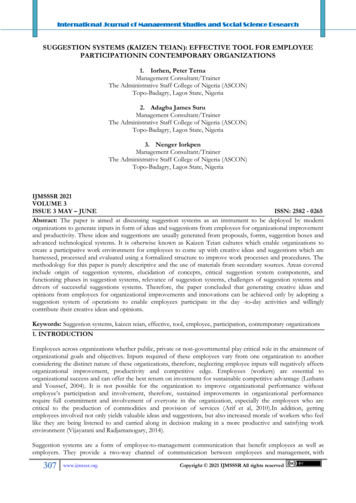
Transcription
International Journal of Management Studies and Social Science ResearchSUGGESTION SYSTEMS (KAIZEN TEIAN): EFFECTIVE TOOL FOR EMPLOYEEPARTICIPATIONIN CONTEMPORARY ORGANIZATIONS1. Iorhen, Peter TernaManagement Consultant/TrainerThe Administrative Staff College of Nigeria (ASCON)Topo-Badagry, Lagos State, Nigeria2. Adagba James SuruManagement Consultant/TrainerThe Administrative Staff College of Nigeria (ASCON)Topo-Badagry, Lagos State, Nigeria3. Nenger IorkpenManagement Consultant/TrainerThe Administrative Staff College of Nigeria (ASCON)Topo-Badagry, Lagos State, NigeriaIJMSSSR 2021VOLUME 3ISSUE 3 MAY – JUNEISSN: 2582 - 0265Abstract: The paper is aimed at discussing suggestion systems as an instrument to be deployed by modernorganizations to generate inputs in form of ideas and suggestions from employees for organizational improvementand productivity. These ideas and suggestions are usually generated from proposals, forms, suggestion boxes andadvanced technological systems. It is otherwise known as Kaizen Teian cultures which enable organizations tocreate a participative work environment for employees to come up with creative ideas and suggestions which areharnessed, processed and evaluated using a formalized structure to improve work processes and procedures. Themethodology for this paper is purely descriptive and the use of materials from secondary sources. Areas coveredinclude origin of suggestion systems, elucidation of concepts, critical suggestion system components, andfunctioning phases in suggestion systems, relevance of suggestion systems, challenges of suggestion systems anddrivers of successful suggestions systems. Therefore, the paper concluded that generating creative ideas andopinions from employees for organizational improvements and innovations can be achieved only by adopting asuggestion system of operations to enable employees participate in the day -to-day activities and willinglycontribute their creative ideas and opinions.Keywords: Suggestion systems, kaizen teian, effective, tool, employee, participation, contemporary organizations1. INTRODUCTIONEmployees across organizations whether public, private or non-governmental play critical role in the attainment oforganizational goals and objectives. Inputs required of these employees vary from one organization to anotherconsidering the distinct nature of these organizations, therefore, neglecting employee inputs will negatively affectsorganizational improvement, productivity and competitive edge. Employees (workers) are essential toorganizational success and can offer the best return on investment for sustainable competitive advantage (Luthansand Youssef, 2004). It is not possible for the organization to improve organizational performance withoutemployee’s participation and involvement, therefore, sustained improvements in organizational performancerequire full commitment and involvement of everyone in the organization, especially the employees who arecritical to the production of commodities and provision of services (Arif et al, 2010).In addition, gettingemployees involved not only yields valuable ideas and suggestions, but also increased morale of workers who feellike they are being listened to and carried along in decision making in a more productive and satisfying workenvironment (Vijayarani and Radjamanogary, 2014).Suggestion systems are a form of employee-to-management communication that benefit employees as well asemployers. They provide a two-way channel of communication between employees and management, with307www.ijmsssr.orgCopyright 2021 IJMSSSR All rights reserved
International Journal of Management Studies and Social Science Researchmanagement accepting or rejecting employee suggestions and, in some cases, commenting on them. Suggestionsystems give employees a voice and a role in determining organizational policies and operating procedures. Thissystem also helps increase efficiency, eliminate waste, improve safety, and improve the quality of products andservices. According to Ehsan et al (2012), suggestion system is taken into account as an advanced method,bringing about the shift from a common labour to a qualified and responsible one. In fact, the labour force has abasic role to help the organization reach the arranged goals, through effective participation and to enhanceperformance. However, the efficient productivity and constant improvements are other objectives of thesuggestion system.Therefore, to ensure continuous participation of employees for sustainable competitive edge acrosscontemporarily organizations, putting in place a formalized and structured mechanism for generating andharnessing inputs from employees which can be evaluated and assessed to improve organizational operationsbecomes crucial and vital, as modern organizations are faced with fierce competition and volatile market.Unfortunately, the traditional suggestion boxes placed at strategic positions across organizations today are notutilized to attract opinions and ideas from employees and therefore, it becomes difficult for creative ideas to begenerated to improve performance, reduce cost, minimise waste, enhance efficiency, etc. In the same vein,Verdinejad et al(2010), saidin most organizations, when ideas are accepted from employees, it happens because theidea creator was persistent and vocal, and exerted a lot of personal energy. It is in this connection that the paper isaimed discussing suggestion systems as instrument which modern organizations can deploy to facilitate employeeparticipation for innovation, organizational improvement, cost reduction, efficiency, etc. Therefore, the paper isdivided into six segments which include origin of suggestion systems, elucidation of concepts, critical suggestionsystem components, functioning phases in suggestion systems, relevance of suggestion systems, challenges ofsuggestion systems and drivers of successful suggestions systems.2. ORIGIN OF SUGGESTION SYSTEMSThe history of suggestion systems can be traced as far back as 1721, when Yoshimune Tokugawa, the 8th Shogun,placed a suggestion box called “Meyasubako” at the entrance of the Edo Castle for written suggestions from hissubjects (Arif et al, 2010). Industrial suggestion systems trace their origin back to the 19th century; in 1880, whenWilliam Denny, a Scottish shipbuilder, asked his employees to offer suggestions in order to build ships in betterways (Islam, 2007). Following this, Kodak company became a pioneer in employee suggestion systems whereWilliam Connors received a price of two dollars in 1898 for suggesting that windows be washed to keep theworkplace brighter (Carrier, 1998)cited in Lasrado et al (2016). Therefore, formal and structured suggestionschemes were first introduced as a modern practice more than one hundred years ago (Lloyd, 1999; McConville,1990) cited in Lasrado et al (2016). Industry associations, such as the Employee Involvement Association (EIA),have come into existence and have contributed greatly to the increased formalization, objectivity, andprofessionalism of suggestion programs. The EIA have instituted educational, statistical, and professionaldevelopment programs to raise the bar of best practices in the encouragement, evaluation, development andimplementation of ideas that add value to their organizations. IdeasUK, the United Kingdom’s foremostassociation for the promotion of employee involvement programs, was also founded in 1987. Its prime purposebeing to assist organizations in both the public and private sector; it’s now an organization with more than 100members worldwide. Suggestion schemes have a considerable history and are now popular throughout the worldincluding the USA, Europe, Asia and the Middle East (Cooley et al, 2001).3. ELUCIDATIONOF CONCEPTSSuggestion systems and employee participation require detailed explanation being key concepts of the paper.Suggestion SystemsSuggestion System also known as Employee Suggestion System (ESS) or Employee Suggestion Scheme (ESS) isthe oldest form of an employee involvement tool and is widely used by organizations to elicit employees’ creativeideas. It plays a pivotal role for organizations wishing to become more innovative (Buech et al., 2010). It isdescribed as a formalized mechanism that encourages employees to contribute constructive ideas for improvingthe organization in which they work (Milner et al, 1995). Cooley et al (2001), described suggestion schemeas a toolthat elicit suggestions from employees, classify them, and dispatch them to the “experts” for evaluation. After this,308www.ijmsssr.orgCopyright 2021 IJMSSSR All rights reserved
International Journal of Management Studies and Social Science Researchthe suggestion might be adopted, in which case the suggestion may well be rewarded. But, even if the suggestion isrejected, the employee may still be rewarded with a token gift.Du Pless et al (2008), in their views said suggestionsystems are atool that encourages employees to think innovatively and creatively about their work and workenvironment, and to produce ideas which will benefit the organization for which the employee will receiverecognition. Fairbank and Williams (2001) argued that suggestion systems are means of facilitating the process ofmotivating employees to think more creatively, to share those creative thoughts and convert creative ideas intovaluable innovations. Staff suggestion scheme is a formalized procedure to encourage the employees to thinkcreatively about their jobs and their job environment and to come forward with ideas for which they will berewarded on a specific basis, if acceptable and to the advantage of the organization (Andrew, 1993).Suggestionsystem known as Kaizen Teian (Japanese term) is a system for generating and implementing employee ideas.Kaizen Teian is a companywide system for employee- managers and workers, continuous improvement proposals.It is an organized way of bringing forward the ideas of employees, no matter how small (Trip and Sunhilde, 2008).Employee suggestion system is a useful tool for organizations which focused on continuous improvement ofprocesses, expansion of their intellectual capital and implementation of inter-department cooperation instead ofcompetition. Ideas are derived not only from people of above average intelligence, but also from those of averageintelligence (Golas et al, 2016).In conclusion, suggestion system can be seen utilizing the untapped ideas and potentials of employees fororganizational innovation and improvement. It involves harnessing creative ideas from employees to improvework processes, procedures and methods to give an organization an edge over its competitors.In line with the above, suggestion systems primarily consist of administrative procedures and infrastructure forcollection, judging and compensating ideas, which are conceived by employees of the organization (Dijk andEnde,2002).In addition, suggestion systems have the capability of being all inclusive by being able to focus oncapturing ideas from all staff, and not just ideas from identified few smart staff (Fairbank and Williams,2001).Suggestion system should be integrated with the organizational culture to achieve greater employee involvementwhich eventually leads to tangible benefits such as cost savings and higher sales and intangible benefits like higherlevels of morale (Darragh-Jeromos, 2005). This serves as motivational factor on the part of the employee.Both public and private sectors of the economy have adopted suggestion systems, for the public sectororganizations, there has been an expression of enthusiasm for suggestion schemes by developed countries as ameans of improving responsiveness to the public, and as means of facilitating innovation and serviceimprovements (Cabinet Office 1999a, 1999b). For the private sector, the motives include the desire to increaseprofits, reduce costs, increase safety, enhance staff morale, and improve staff retention (Ideas UK, 2001).Suggestion systems or schemes offer financial incentives for private sector, and this is specifically encouraged inthe public sector (IRS Employment Review, 1996; Cabinet Office, 1999c).Nowadays many organizations areaware of the importance of employee creativity, as suggestion systems are among the instruments for channellingcreativity (Dijk and Ende, 2002).Employee ParticipationGetting employees involved in day-to-day running of organization is now becoming a culture across modernorganizations due to its relevance. In the face of constant pressure to increase organizational performance, aplethora of intervention have been adopted and developed to increase the effective use of human resources(Hollinshead et al, 1999). Among these are employee involvement initiatives, or high involvement work practices,concerned with harnessing employee potentials and integrating them into business strategy and aligningemployee’s interest with those of their organization. According to Vijayarani (2014), employee involvement is abroader concept and the foundation of employee job satisfaction, creativity, and commitment, motivation andperformance. Is a practice that allows employees to give their inputs and ideas for improvement of organizationalperformance? Employee involvement is a process for empowering employees to participate in managerialdecision-making and improvement activities appropriate to their levels in the organization(Apostolos,2000).Employee participation can be defined as the employees’ active involvement in planning and implementinga teamwork intervention (Hurrell, 2005). Therefore, employee participation is linked with changes in proceduresthat employees are involved with, such as decision making, planning and team work among others. Several aspectsof participation in an organization include the opportunity for employees to achieve their goals, way of seekingnew ideas by the employees and assignment of responsibilities to employees (Gibson et al.,1992). In conclusion,309www.ijmsssr.orgCopyright 2021 IJMSSSR All rights reserved
International Journal of Management Studies and Social Science Researchemployee participation is the process of creating an enabling environment for the workforce to actively contributetheir ideas and experiences in the day -to- day activities of the organization. The primary aim is to harness ideasand potentials from the employees and utilize them for innovation, efficiency, cost reduction, participation andalso provides a feedback for the management as both stakeholders are necessary for the survival and growth ofthe organization.4. CRITICAL SUGGESTION SYSTEM COMPONENTSLasrado et al (2016), pinpointed administrative system, publicity, resources, rewards and feedback and evaluationas elements of suggestion system while Neagoe and Klein(2009), said each suggestion system should represent acycle with four major components which are: (i) encouraging people to participate, (ii) motivating them to writeproposals (either implemented or unimplemented ideas), (iii) review, evaluation and implementation and (iv)award payments and commendations.Figure1: Suggestion System ComponentsSource: Authors’ DescriptionThe figure above describes the smooth flow of suggestion system components from one stage to another, whichare discussed below.Firstly, as employees get convinced that organization can accept their ideas and opinions for organizationalimprovements, innovations and changes, they are encouraged to participate in coming forward with creative ideaswhich are harnessed for processing.Secondly, employees who are willing to come forward with ideas whether creative or not, should be motivated todocument and submit them through proposals. It is by submitting these proposals that someone can reallyunderstand areas of operations that need to be improved upon.Thirdly, Neagoe and Klein (2009) said that the biggest obstacles in the suggestion cycle lie in the area of review,evaluation, guidance and implementation. When employees submit their ideas for evaluation and never receivefeedback from the examiners, they feel dejected and frustrated. Insensitive comments of proposal reviewers cansometimes kill an employee’s improvement initiative. Even if the evaluator means no harm in a written answer310www.ijmsssr.orgCopyright 2021 IJMSSSR All rights reserved
International Journal of Management Studies and Social Science Researchand his/her intent is not clearly communicated, it results to negative misinterpretations. When the review,evaluation and guidance aspect of the system functions properly, it can be a great motivating force that will attractmany excellent proposals. Suggestion activity will never function properly when this component of the process isneglected. In reviewing the suggestions, some organizations assign a Suggestion Committee who reviews theproposal, makes decisions whether it should be adopted or not and inform the author of the decision. If adopted,the committee instructs the management to implement the suggestion, and decides what award should be given tothe person who submitted the suggestion. Other organizations consider that the employees who are in charge ofthe workplace examine suggestions on the spot, and since colleagues and supervisors know the workplace betterthan anybody else does, they know about potential problems and where the difficulties are likely to beencountered. More importantly, for suggestions which require important technical changes, the process engineermust be consulted, in order to be sure that the implementations do not negatively affect other process elements.Therefore, it is not recommended for one evaluator to examine suggestions, because one evaluator’s assessmentcan be biased, and a situation where employees feel that their suggestions are not well evaluated and rejected fairly,they can appeal to the top management for reassessment.Fourthly, the implementations of evaluated suggestions which have been accepted by the top management fororganizational improvement require reward. Organizations differ in reward system, some give one-off standardpayments regardless of the impact of the suggestion, some make one-off payment while other rewards includebonus “points”, by awarding those making the suggestions with number of “points” which are accumulated andexchanged for gifts. Beyond monetary rewards, other types of rewards such as paid holidays to country of interest,letter of commendation, dinner with family members and friends which serves as motivation can also beconsidered.In summary, the four components discussed must create a favourable environment for employees to contributetheir ideas by writing them in form of proposals for consideration, which can be evaluated for acceptance orrejection for implementation by top management with accompanied rewards like payments, gifts andcommendations among others.5. FUNCTIONING PHASES IN SUGGESTION SYSTEMSThe functioning and implementation of an effective system is highly influenced by factors other than financialincentives. Among these factors, two are very essential, that is individual related and organizational related factors(Amabile, 1983 and Simonton, 1976). The individual related factor deals with the influence of the personalities ofcreative individuals while the organizational related factor deals with culture and structure. The cultural factorincludes management support (Amabile, 1996), preparedness for changes (Voorendonk, 1998), clear mission andstrategy (Christensen,2000), attitude of fellow workers (Amabile, 1996) while the structural factors includeexistence of adequate evaluation procedures (Tropman,1998), presence of a rewarding structure (Imai, 1986) andallocation of means to support and work out ideas (Robinson and Stern, 1997).According to Abernathy and Clark(1985), the consideration given to both cultural and structural factors willenable organizations optimize the design of their suggestion system which will serve as a catalyst for generatingcreative ideas and opinions for innovation, be it technological, a market related innovation or a combination ofboth(Abernathy and Clark, 1985). Therefore, the functioning of suggestion systems is depicted below with threephases which are influenced by organizational culture and structure.Figure 2: Functioning Phases in Suggestion SystemsSource: Dijk, C.V. and Ende, J.V. (2002)311www.ijmsssr.orgCopyright 2021 IJMSSSR All rights reserved
International Journal of Management Studies and Social Science ResearchThe above diagram is made up of three major phases and stages responsible idea extraction, idea landing and ideafollow-up.Idea extraction which is the first phase is the ability of the organization to harness ideas shared by employees fromtheir willingness due to the cultural environment that stimulates open and free communication among employees.Idea landing being the second phase is the ability of the employees to drop or submit their ideas with organizationto be utilized, and it requires that cultural factors be placed for positive reaction towards the initiator of any idea.It also requires structural factors like accessible suggestion system.Idea follow-up is the third and last phase which ensures that the ideas submitted by employees are processedthrough collation for evaluation by sub-committees which can either be accepted or rejected at the end of theevaluation exercise for implementation with commensurate rewards.6. RELEVANCE OF SUGGESTION SYSTEMSMilneret al (1995) identified greater morale and increased employee involvement as benefits of suggestion systemswhile Verdinejad et al (2010) said suggestion systems are one of the popular ways of taking advantage of personnelcreativity.Moica et al (2019) also highlighted employee motivation, continuous improvement and managementcommitment as organizational gains of suggestion systems. Therefore, harnessed and generated ideas fromemployees using suggestion systems are of numerous benefits not only to organizations, but also to employees.Organizational Benefits Effective communication between management and stakeholders: As organizations set up platform forcollecting ideas and suggestions, all relevant stakeholders like employees, suppliers, customers, shareholders,etc relate and interact among themselves through which ideas are generated to improve the organizationaloperations.Efficiency: Suggestions from employees to deploy modern technology and equipment for operations andalso to engage more suppliers for competition reduce cost and brings about utilization of organizationalresources.Innovation: Creative ideas and suggestions are translated to new products and services to give organizationan edge over competitors.Increase in revenue: New products and services attract new charges and prices which enhanceorganizational revenue.Continuous improvement: So far as employees keep submitting ideas and suggestions, there is continuousimprovement in operational processes, procedures and methods for quality products and services.Conducive work environment: Suggestion systems platform create a peaceful work setting for employeesto reason and think together to improve the organizational operations.Utilization of internal competencies: Suggestion systems enable organizations to rely on employee ideasand suggestions for changes and improvements rather than hiring external consultants for a fee.Customer/client satisfaction: Improvement in products and services are products of creative ideas thatgives organizational customers and client’s desired satisfaction that facilitates sustainable patronage for theorganization.Employee Benefits Teamwork: Suggestion systems bring employees together to share ideas on operational issues affectingorganizational performance. And as these employees work together, they develop team spirit.Enhance employee morale: Receiving and recognizing ideas and suggestions submitted by employees givethem a sense of belonging that they are valued. This serves as a morale booster and encouragement to submitmore ideas.312www.ijmsssr.orgCopyright 2021 IJMSSSR All rights reserved
International Journal of Management Studies and Social Science Research Effective communication among employees: As organization set up a platform for collecting ideas andsuggestions, its workforce become free and open to themselves in their interactions to come forward withcreative ideas.Develop problem solving capabilities: The willingness of employees to come up with ideas empowerthem with required skills to solve operational issues.Creative thinking: Employees are compelled to be creative and innovative in coming up with ideas that canbring new products and improved services.Minimize change resistance: As employees become use to suggestion system for improvement, it becomesan operating culture that minimizes change resistance.Tangible and intangible rewards: Employees are rewarded with payments, gifts, letter of commendations,promotions, words of appreciation and encouragement.7. CHALLENGES OF SUGGESTION SYSTEMSThe setting up and implementation of an effective suggestion system is faced with numerous problems. Amongthese problems are lack of management support, unfriendly operating environment, strict rules on participation,low or no response, unclear explanation on acceptance and rejection of ideas, biased judgement and inconsistentand unpredictable rewards (Lasrado, 2017).Lack of management support: The inability of organizational management to consider ideas and opinions of itsemployees for improvements and changes, discourage employees from coming forward with creative ideas.Studies have shown that a traditional, autocratic management style results in low levels of employee engagementand motivation (Hayward, 2010). Leadership styles that include threats, intimidation, and coercive tactics appearto universally discourage creative behaviour on the part of employees (Anderson and Veillette, 2008).Unfriendly operating environment: Work environment that is hostile with coercive rules discourage employeesfrom submitting creative ideas due to fear.Strict rules for participation: Stringent conditions and requirements for ideas and opinions to be submitted candiscourage employees from coming forward with ideas.Lack of feedback: The inability of the evaluation committee to get back to employees on ideas submitteddiscourage them from bringing more ideas. If employees do not receive feedback, they may feel management istaking credit for their suggestions (Mishra, 1994).Unclear justification on ideas accepted and rejected: Employee whose ideas are accepted are willing to getencouraging reasons and value which these ideas have added, and therefore, the inability for this explanationbecomes a problem. As similar explanations are expected of ideas rejected.Lack of objectivity: A situation where administrators and evaluators of this system are not honest with theprocess by being bias, the goals of getting creative ideas and opinions from the pool is defeated.Inconsistent rewards: Failure to provide employees with the agreed rewards for ideas submitted demotivate suchemployees.In addition to these challenges, is lack of suggestion system structure with system administrators for processing ofsuggestions, evaluators with expert knowledge for assessing the merits of suggestions, awards panels forapportioning rewards and implementation managers responsible for implementing suggestions approved. Anotherchallenge is lack of suggestion implementation, when ideas submitted and evaluated are not put into action,employees feel their suggestions are not operational.8. DRIVERS OF SUCCESSFUL SUGGESTION SYSTEMSAccording to Bell (1997), said the “goal of a successful suggestion system is to tap the reservoir of ideas andcreative thinking of all employees for the improvement of the work process”. To achieve this, Weber and Smiles313www.ijmsssr.orgCopyright 2021 IJMSSSR All rights reserved
International Journal of Management Studies and Social Science Research(2017), said there should prompt feedback from management on ideas submitted and no idea should be neglected.While factors like simplified and effective system, individual attributes, publicity, resources, rewards, feedback andevaluation, expertise, suggestion implementation, empowerment and organizational support are considered asmajor success factors of suggestion systems which were attested to by (Koc and Ceylan, 2007; Mishra, 1994;Hultgren, 2008; Mc Conville, 1990; Monge, Cozzens and Contractor, 1992; Yuan and Zhou, 2008;Verespej,1992;Neagoe and Klein, 2009; Dijk and Ende, 2002; Ahmed, 2009; Du Plessis et al., 2008; Klijn and Tomic,2010;Wynder, 2008; Recht and Wilderom, 1998; Malaviya and Wadhwa, 2005; Amabile et al., 2004 and Aoki,2008).Simplified administrative suggestion systemsEnsuring that a mechanism to elicit employee ideas is necessary through which employees can make theirsuggestions. This mechanism enhances the number, and the quality of ideas. Therefore, the design of aninfrastructure with simple methods for submitting suggestions is a key aspect of the suggestion systems. The morecomfortable employees are with the format, the more suggestions will be received, and the more money will besaved (Mishra, 1994).Individual attributesThe effectiveness of any system for generating ideas hinges on employees who are creative in ideas to invent orpropose useful innovationsPublicityCreating awareness among organizational members of the gains of implemented suggestions in order to encouragecreative ideas to be contributed is very important for suggestion systems.ResourcesThe success of a suggestion system lies not only in generating the creative ideas but also in the implementation ofthese ideas. Indeed, resources support the idea realization process. If organization slack the necessary resources,even the best suggestions received wouldn’t be fruitful. Therefore, main influences for a successfulim
The history of suggestion systems can be traced as far back as 1721, when Yoshimune Tokugawa, the 8th Shogun, placed a suggestion box called "Meyasubako" at the entrance of the Edo Castle for written suggestions from his subjects (Arif et al, 2010). Industrial suggestion systems trace their origin back to the 19th century; in 1880, when
